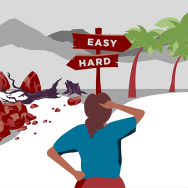《懷德海對話錄》中的"美國 slangs的活力 ‘sludge’、 ‘nudges’
Freakonomics - The hidden side of everything
Freakonomics ...
https://freakonomics.com
Beneath the surface is a tangled web of dealers, curators, auction houses, speculators — and, of course, artists. In the first episode of a three-part series, ...
《蘋果橘子經濟學》
Critical Moment for Roe, and the Supreme Court’s Legitimacy
As justices consider Mississippi’s restrictive abortion law, scholars debate what a reversal of Roe v. Wade would mean for the court’s credibility.
Fearing a repeat of Jan. 6, some members of Congress are pushing to change a little-known electoral count law.
***
Sludge is a solid byproduct generated from water and the wastewater treatment process.
Sludge is a semi-solid slurry that can be produced from a range of industrial processes, from water treatment, wastewater treatment or on-site sanitation systems. ... Sludge can consist of a variety of particles, such as animal manure.
梅原真《重塑日本風景:頂尖設計師的地方創生筆記》台北:行人,2021
第一級產業 x Design=風景
地方創生設計大師梅原真,30年來協助日本一級產業創新的核心概念全蒐錄。
「打造出具有存在感、相應於斯土的表情,就是我的工作。」
超過三十名一級產業委託人成功案例,協助一級產業做全新設計,創造「新價值」,
展現日本最美在地風景!
給不論從事行銷、設計、地方創生或這些以外的你,一些溝通的思維及靈感!
熱愛地方的梅原真,思考可以為地方做些什麼?
本書可以看見作者思考脈絡的集大成,其中有提案成功的,也有在草案時就失敗的,不論是什麼階段,如何發想,如何了解品牌的需求,一步步切出核心,用「設計」為商品發聲,展現品牌魅力。
透過親身了解委託人的背景,為商品加入故事,增添品牌獨特性外,更多了最可貴的人.情.味。
「已經到了會讓人不自覺產生嫉妒之情的程度。」──平面設計大師 原研哉
「相信阿梅!」──國際插畫家 大橋步(書封「不行不行人」繪製、命名者)
書中節選,梅原桑語錄:
►喜歡巨大的東西、喜歡規模龐大的東西;很有錢的人比較了不起、具權勢的人就是好人,認同這種價值觀,不論社會整體或個人都很驕傲……沙灘美術館的本質,可說是針對這種時代提出的諷刺。〈漂流物展〉
►極端辛苦的工作,第一級產業的底層。我們的社會,必須是能讓這些人豐足生活的社會才行!〈漁夫釣漁夫烤〉
►什麼樣的人在摘採青海苔?什麼樣的人在曬青海苔?想像著這些畫面而做設計,進行設計之際,我的腦海也總是浮現著「風景」這個詞彙。〈曬川海苔的風景〉
►在銷售商品之前,不該是先讓人看見「信念」嗎?〈last river〉
Seeking a Mideast Path, Bush Offers a Nudge By STEVEN LEE MYERS
President Bush’s vision for two-state peace is ambitious but his strategy is cautious, and the real measure of the talks will be what happens afterward.“助推”概念的興盛與普及,很大程度上得益於2008年塞勒與哈佛大學教授凱斯•桑斯坦(Cass Sunstein)合著的《助推》(Nudge: Improving Decisions about Health, Wealth, and Happiness)一書。書中首次提出了“選擇架構(choice architecture)”的理念,即“為了用多種方法將選擇展現給消費者所做的設計,以及這種展現對消費者做出決定所產生的影響”。而“助推”指的就是“選擇架構”的任一方面,只要可以用特定的方式改變人們的行為,並且不禁止任何選擇,或是顯著改變人們的經濟動機。相應地,“選擇架構者”就是設計“選擇架構”和進行“助推”的人。這些概念一經提出,便被多國政治、經濟領導人及政策制定者重視及應用,取得了包括助推人們簽署器官捐獻協議、提高養老金繳款在內的多項顯著成就,“讓大家更容易地做出正確的選擇”。
How much can you ‘nudge’ for good? Richard Thaler explores possibilities, limits

In revised book, Nobel laureate examines ‘sludge’—and when ‘nudges’ aren’t enough
Prof. Richard Thaler thinks it’s time to update and contextualize a term he helped coin.
A Nobel laureate and leading behavioral economist at the University of Chicago, Thaler is the author of Nudge: Improving Decisions About Health, Wealth and Happiness, co-authored with former UChicago law professor Cass Sunstein. In the 2008 book, they define “nudges” as small manipulations of the choices people are faced with in daily life: boxes checked by default on a form, or snacks for sale in the checkout aisle.
People often think of nudges as small tweaks, but their impact can still be significant, according to Thaler: Automatically enrolling employees in 401k plans, for example, can dramatically increase their career-long savings.
On Nov. 3, Chicago Booth’s Center for Decision Research (CDR) hosted Thaler and Prof. Nicholas Epley for a hybrid installment of the “Think Better” speaker series, in which Thaler discussed a new revision of the book, titled Nudge: The Final Edition. More than 400 people attended in person at the University of Chicago’s David Rubenstein Forum in accordance with COVID-19 safety guidelines, with an additional 1,800 watching live via Zoom webinar.
Thaler, the Charles R. Walgreen Distinguished Service Professor of Behavioral Science and Economics at the Booth School of Business, began his talk with the story of how he and Sunstein arrived at the term “nudge.” He recounted how he initially pitched the title of “Libertarian Paternalism is Not an Oxymoron,” which left publishers unconvinced. Ironically, a publisher who had passed on the book eventually suggested the title “Nudge.”
Effective “nudges” are the result of what Thaler calls “choice architectures”: Instances in which people actively design menus, store layouts and other environments in which other people make decisions, such that design attributes “nudge” users’ decisions in certain directions.
While Thaler argues that nudges should be used to design environments that encourage actions that improve human wellbeing and happiness—to slow traffic or encourage healthy eating, for example—choice architects can also design structures that frustrate and complicate our lives with unnecessary burdens.
Thaler and Sunstein dive into this idea in the latest edition of Nudge, describing these bad nudges as “sludge.” For example, a newspaper that allows you to subscribe with one click but requires you to call during limited hours to cancel is employing sludge. Sludge adds friction to prevent people from achieving their goals.
In the early days of 401(k) plans, Thaler noted, many workers failed to join—even with generous matching contributions from the employer—because the process was too complex, full of decisions and financial terminology. In effect, sludge.

In 2004, however, Thaler co-authored a paper with UCLA economist Shlomo Benartzi that outlined simple ways to improve the choice architecture for encouraging employees to choose a retirement savings plan—starting with the default option of being opted into an indexed fund unless the employee took the additional step of choosing something else. This simple change in choice architecture has profoundly impacted the retirement savings market.
Free choice doesn’t necessarily lead to good decisions, according to Thaler, especially in cases with too many options. For example, in one large company’s health insurance package, employees were offered 48 possible plans, which led many to choose plans which were financially worse for them than the default plan.
During the talk, Thaler presented a number of other examples of how to optimize choice architectures in different scenarios. He and Epley, faculty director for CDR, then discussed questions submitted by audience members before the event, some of which centered on the limits of nudging.
When asked about climate change, Thaler warned, “We’re not going to win this battle with nudging.” Instead, he called for pricing carbon: “If something is free, people consume too much of it—just go to a wedding with an open bar.”
He and Epley—the John Templeton Keller Professor of Behavioral Science at Chicago Booth—also reflected on why nudges to encourage COVID-19 vaccination haven’t been as effective as hoped. Thaler noted it may take more time and assessment to determine how truly effective these nudges have been, but he also advocated for vaccine mandates to achieve herd immunity, comparing such rules to bans on smoking in public.
Thaler closed the talk by teasing his future plans—working on a new edition of his book The Winner’s Curse with Asst. Prof. Alex Imas at the Chicago Booth School of Business.
verb
1 [T] to push something or someone gently, especially to push someone with your elbow (= the middle part of your arm where it bends) to attract their attention:
The children were giggling and nudging each other.
He nudged the cat off the sofa so that he could sit down.
2 [I + adverb or preposition; T] to move slowly and almost reach a higher point or level:
Oil prices continue to nudge higher.
Peter must be nudging 40 now.
nudge
noun [C]
when you nudge someone or something:
I gave him a nudge to wake him up.
DJ: [



 ]
]- 用肘輕推(以引起注意);輕推
- 推進;刺激
- 輕推,推進[Q]
- 輕推;推動[C]




沒有留言:
張貼留言